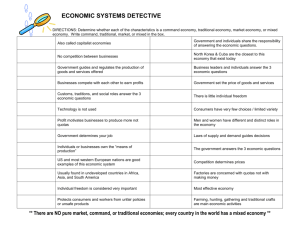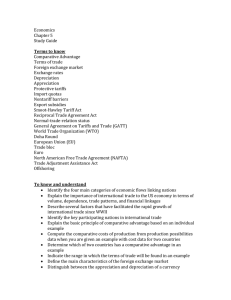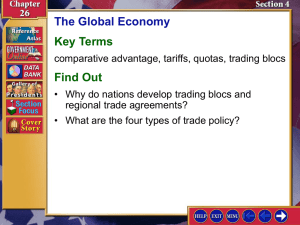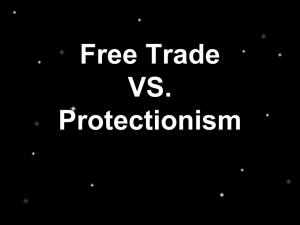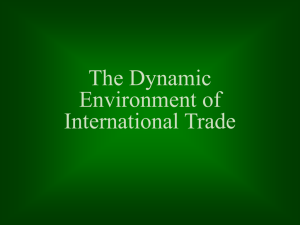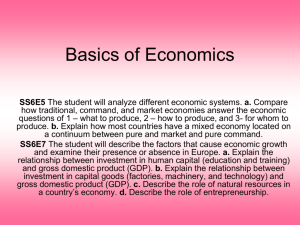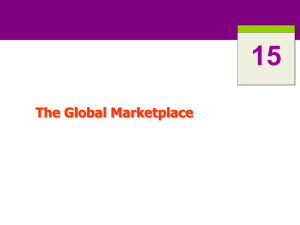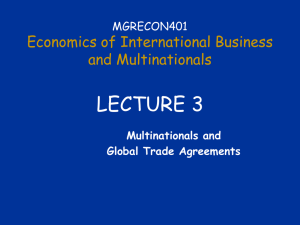Industrializing economies – Emerging Markets
advertisement
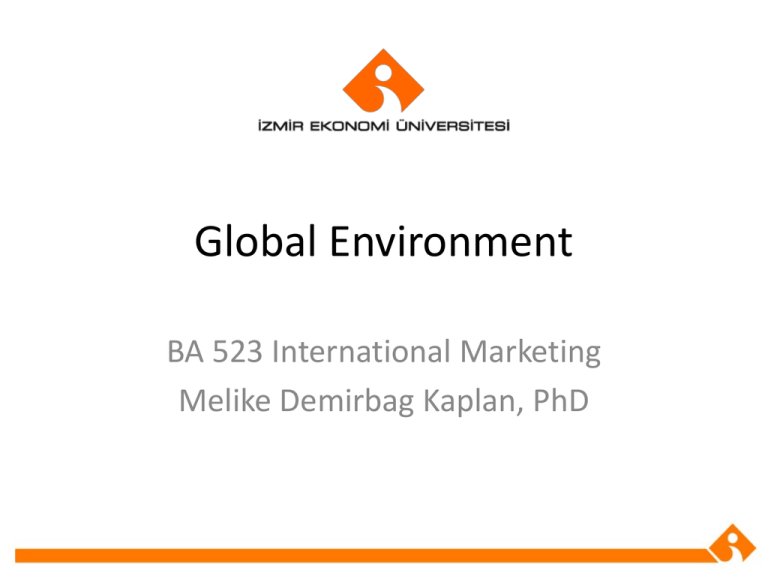
Global Environment BA 523 International Marketing Melike Demirbag Kaplan, PhD Global Marketing in the 21st Century The world is shrinking rapidly with the advent of faster communication, transportation, and financial flows. International trade is booming and accounts for 20 percent of GDP worldwide. Global competition is intensifying. Higher risks with globalization. A Global Firm Operates in more than one country Gains marketing, production, R&D, and financial advantages not available to purely domestic competitors The global firm sees the world as one market Basic Questions Global firms ask a number of basic questions: What market position should we try to establish in our own country, in our economic region, and globally? Who will our global competitors be, and what are their strategies and resources? Where should we produce or source our product? What strategic alliances should we form with other firms around the world? Key Influences in the Global Marketing Environment The International Trade System Economic Environment Political-Legal Environment Cultural Environment Key Influences (Trade) The International Trade System: Restrictions—tariffs, quotas, embargos, exchange controls, and nontariff trade barriers. The World Trade Organization and GATT: Helps trade—reduces tariffs and other international trade barriers. Regional Free Trade Zones: Groups of nations organized to work toward common goals in the regulation of international trade. Tariffs & Quotas Tariffs are taxes on certain imported products designed to raise revenue or to protect domestic firms Quotas are limits on the amount of foreign imports a country will accept in certain product categories to conserve on foreign exchange and protect domestic industry and employment Exchange Controls & Nontariff Barriers Exchange controls are a limit on the amount of foreign exchange and the exchange rate against other currencies Nontariff trade barriers are biases against bids or restrictive product standards that go against a particular country’s product features GATT & WTO General Agreement on Tariffs and Trade (GATT): A 61-year-old treaty Designed to promote world trade Reduces tariffs and other international trade barriers World Trade Organization Enforces GATT rules Mediates disputes Imposes trade sanctions Regional free trade zones such as the European Union, NAFTA or CAFTA help to simplify the process of going global. Economic Environment Economic factors reflect a country’s attractiveness as a market: Industrial structure Income distribution Economic Environment Industrial Structure: Shapes a country’s product and service needs, income levels, and employment levels. Four types: Subsistence economies Raw material exporting economies Industrializing economies – Emerging Markets Industrial economies Economic Environment Income Distribution Low-income households Middle-income households High-income households More than half of China’s 1.3 billion consumers can barely afford rice. More than 400 million Chinese live on less than $2 a day (WB) Gucci,Cartier, Lexus and Bentley? Emerging Markets What are Emerging Markets? Regional economic powerhouses -large populations, large resource bases, and large markets Adopting open door policies to replace their traditional state policies that failed to produce sustainable economic growth. World’s fastest growing economies By 2020, the five biggest emerging markets' share of world output will double to 16.1 percent from 7.8 percent in 1992. They will also become more significant buyers of goods and services than industrialized countries Critical participants in the world's major political, economic, and social affairs. Asia: China, India, Indonesia, Malaysia, Philippines, Singapore, South Korea, Thailand Africa and the Middle East: Eastern Europe: South Africa and Israel The Czech Republic, Hungary, Greece, Portugal, Turkey The Former Soviet Union: Latin America: Russia, Ukraine, and the Baltic's Argentina, Brazil, Chile, Mexico, Venezuela http://en.wikipedia.org/wiki/Emerging_markets The 86% Markets The developed world - GNP of over $10K per capita- constitutes only 14% of the world’s population 86% of the world – the emerging markets - has a GNP of less than $10K per capita It is this 86% that represents the future of global commerce 14% 86% GNP per capita greater than $10K GNP per capita less than $10K Political – Legal Environment Country’s attitude toward international buying Government bureaucracy Political stability Monetary regulations Demographic Environment Increasing Population Net increase of 3 people per second 93 million per year 98 % occurring in developing countries Aging & Urbanization Cultural Environment The cultural environment refers to factors and trends related to how people live and behave. Values Subgroup Activities Beliefs Ideas Cultural Factors Attitudes Cultural Environment Sellers must examine the ways consumers in different countries think about and use products before planning a marketing program. Business norms and behavior vary from country to country. Companies that understand cultural nuances can use them to advantage when positioning products internationally. Understanding Cultures Low Context vs. High Context (Hall, 1976) Cultural Dimensions Theory (Hofstede, 1980) Individualism vs. Collectivism Masculinity vs. Femininity Power Distance Uncertainty Avoidance Long Term Orientation LG Kimchi Fridge If you’ve got kimchi in your fridge, it’s hard to keep it a secret. Made from fermented cabbage seasoned with garlic and chili, kimchi is served with most meals in Korea. But when it’s stored inside a normal refrigerator, its pungent odor taints nearby foods. That’s why, two decades ago, LG introduced the kimchi refrigerator, featuring a dedicated compartment that isolates smelly kimchi from other foods. Kimchi refrigerators now have become a fixture in 65 percent of Korean homes, and LG is the country’s top-selling manufacturer. Importance of Culture Ignoring cultural differences can result in strong consumer backlash. Nike was forced to pull these shoes from distribution after learning that the stylized shoe logo resembled “Allah” when written in Arabic. Homework http://deepblue.lib.umich.edu/bitstream/202 7.42/39704/3/wp320.pdf Rethinking Marketing Programs for Emerging Markets. By: Niraj Dawar and Amitava Chattopadhyay.

